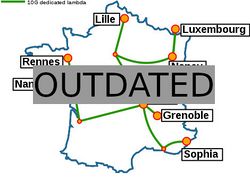Grid5000:Home: Difference between revisions
No edit summary |
No edit summary |
||
| Line 7: | Line 7: | ||
Key features: | Key features: | ||
* provides '''access to a large amount of resources''': 12000 cores, 800 compute-nodes grouped in homogeneous clusters, and featuring various technologies: GPU, SSD, NVMe, 10G Ethernet, Infiniband, | * provides '''access to a large amount of resources''': 12000 cores, 800 compute-nodes grouped in homogeneous clusters, and featuring various technologies: GPU, SSD, NVMe, 10G and 25G Ethernet, Infiniband, Omni-Path | ||
* '''highly reconfigurable and controllable''': researchers can experiment with a fully customized software stack thanks to bare-metal deployment features, and can isolate their experiment at the networking layer | * '''highly reconfigurable and controllable''': researchers can experiment with a fully customized software stack thanks to bare-metal deployment features, and can isolate their experiment at the networking layer | ||
* '''advanced monitoring and measurement features for traces collection of networking and power consumption''', providing a deep understanding of experiments | * '''advanced monitoring and measurement features for traces collection of networking and power consumption''', providing a deep understanding of experiments | ||
Revision as of 10:05, 9 November 2018
|
Grid'5000 is a large-scale and versatile testbed for experiment-driven research in all areas of computer science, with a focus on parallel and distributed computing including Cloud, HPC and Big Data. Key features:
Older documents:
|
Random pick of publications
Five random publications that benefited from Grid'5000 (at least 2517 overall):
- Vladimir Ostapenco, Laurent Lefèvre, Anne-Cécile Orgerie, Benjamin Fichel. Modeling, evaluating, and orchestrating heterogeneous environmental leverages for large-scale data center management. International Journal of High Performance Computing Applications, 2023, 37 (3-4), 10.1177/10943420231172978. hal-04047008 view on HAL pdf
- Marc Jourdan, Rémy Degenne, Dorian Baudry, Rianne de Heide, Emilie Kaufmann. Top Two Algorithms Revisited. NeurIPS 2022 - 36th Conference on Neural Information Processing System, Nov 2022, New Orleans, United States. hal-03825103 view on HAL pdf
- Quentin Acher, Claudia-Lavinia Ignat, Shadi Ibrahim. Quantifying the Performance of Conflict-free Replicated Data Types in InterPlanetary File System. DICG 2023 - 4th International Workshop on Distributed Infrastructure for Common Good, Dec 2023, Bologna, Italy. pp.1-6, 10.1145/3631310.3633488. hal-04337761 view on HAL pdf
- Tulika Bose, Nikolaos Aletras, Irina Illina, Dominique Fohr. Domain Classification-based Source-specific Term Penalization for Domain Adaptation in Hate-speech Detection. COLING 2022 - Proceedings of the 29th International Conference on Computational Linguistics, Oct 2022, Gyeongju, South Korea. hal-03815708 view on HAL pdf
- Gustavo Salazar-Gomez, David Sierra González, Manuel Alejandro Diaz-Zapata, Anshul Paigwar, Wenqian Liu, et al.. TransFuseGrid: Transformer-based Lidar-RGB fusion for semantic grid prediction. ICARCV 2022 - 17th International Conference on Control, Automation, Robotics and Vision, Dec 2022, Singapore, Singapore. pp.1-6. hal-03768008 view on HAL pdf
Latest news
Failed to load RSS feed from https://www.grid5000.fr/mediawiki/index.php?title=News&action=feed&feed=atom: Error parsing XML for RSS
Grid'5000 sites
Current funding
As from June 2008, Inria is the main contributor to Grid'5000 funding.
INRIA |
CNRS |
UniversitiesUniversité Grenoble Alpes, Grenoble INP |
Regional councilsAquitaine |


